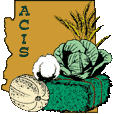
|
|
|
|

|
|||
|
|
|||
|
|
|||
Spinach is a member of the plant family Chenopodiaceae, which also contains the crop plants beets and Swiss chard as well as weeds such as nettleleaf goosefoot and lambsquarters. Downy mildew can develop on all of these plants. Peronospora farinosa, the oomycete pathogen that causes the disease on this group of plants, exists as different races or subtypes. A spinach grower may wonder if isolates of the pathogen that cause downy mildew on beets, Swiss chard, or weed hosts can cause downy mildew on spinach. Monterey County, California Farm Advisor Steve Koike and colleagues conducted research to answer this question. Isolates of the pathogen from nettleleaf goosefoot, lambsquarters, beet and Swiss chard were each used to inoculate spinach; however, downy mildew did not develop. In a separate experiment, the downy mildew pathogen from spinach was used to inoculate nettleleaf goosefoot and lambsquarters. The result again was no disease development. The bottom line is that spinach growers need not worry about nettleleaf goosefoot, lambsquarters, beets or Swiss chard as potential sources of inoculum for their spinach crop. Even though the bluish-purple evidence of the pathogen on the underside of leaves is similar in appearance on all of these plants, the particular isolates of the downy mildew pathogen have very specific and limited host ranges. |
|||
| Back | |||
|
For questions or comments on any of the topics please contact Marco Pena at the Yuma Agricultural Center.
|
|||
|
Home |
Cotton | Veggies |
Forages | Grains
| Citrus |
Crop x Crop Insects | Diseases| Weeds | Pesticides | Economics | News | Weather | Research | Photos | Contacts | General Info. Copyright © 2001 University of Arizona, College of Agriculture and Life Sciences Webmaster: Al Fournier (acis@ag.arizona.edu) |
|||
